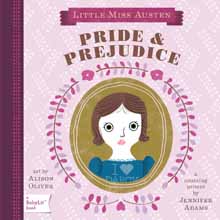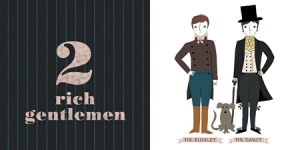 As I try to maintain a serious discussion about the value of adaptations of Jane Austen’s works for an audience which may not already be familiar with her, I find myself confronted with this book. I managed to bury all knowledge of its existence deep in the recesses of my brain; it only returned to my notice because of a rant I indulged in over at Not Just for Kids about the board book version of Jane Eyre. And since I plan to look at books for middle grade readers as well as young adults–I figured I might as well toss this into the mix.
As I try to maintain a serious discussion about the value of adaptations of Jane Austen’s works for an audience which may not already be familiar with her, I find myself confronted with this book. I managed to bury all knowledge of its existence deep in the recesses of my brain; it only returned to my notice because of a rant I indulged in over at Not Just for Kids about the board book version of Jane Eyre. And since I plan to look at books for middle grade readers as well as young adults–I figured I might as well toss this into the mix.
The Little Miss Austen Pride and Prejudice is clearly not written for a young adult audience. In fact just who is it written for? It’s a board book, so the obvious answer is, it is written for babies. But that raises the more problematic question of, what do babies need with Pride and Prejudice? Well, in this case, Pride and Prejudice has been adapted as a counting book. Okay–babies need counting books. But why base one on Pride and Prejudice? Could it be because adults with purchasing power like Pride and Prejudice? Hmmm…that sounds like a cynical marketing ploy. But maybe I am the cynic. Maybe these books are really meant to edify. In fact, the back of the book claims that “BabyLit is a fashionable way to introduce your child to the world of classic literature.” (I suppose the unfashionable way would be to read the actual classic to said child.) So the intended audience of the book is children after all! And yet, only an adult who has actually read Pride and Prejudice would understand why “4 marriage proposals” or “5 sisters” or “10 10,000 pounds a year” is significant. They get to have a little “a-ha moment” while their baby wears the book like a hat. Or, better yet, throws it aside in favor of something they can relate to, like Goodnight Gorilla or Each Peach Pear Plumb (now that is a book which cleverly introduces classics to children in a meaningful way.)
This is not meant to be a snobbish rant about what is suitable reading material for grown-ups. Hey–if adults want to read a board book based on Pride and Prejudice and have a chuckle, have at it. And frankly, I am completely in favor of adults reading childrens books for fun. But I am discussing adaptations, and this particular book is a poor adaptation of Pride and Prejudice, and I cannot forgive that. You don’t play with perfection and then produce pap. The book’s success, both as an adaptation and a reading experience, is entirely dependent on the reader’s knowledge of the original. If one is not already familiar with Kitty and Lydia’s obsession with Red Coats, “7 soldiers in uniform” falls flat and is meaningless; it’s just a random stop between 1 and 10.
 At their best, adaptations are love letters between an admirer and the original source. At their worst they are vanity projects which nick the best elements from someone else’s story. I expect most of the books I will read for this project will probably fall somewhere in the middle, providing in-jokes to readers in the know and a pleasant enough read for everyone else. But I’m pretty sure I will not find one as spectacularly off the mark as this one.
At their best, adaptations are love letters between an admirer and the original source. At their worst they are vanity projects which nick the best elements from someone else’s story. I expect most of the books I will read for this project will probably fall somewhere in the middle, providing in-jokes to readers in the know and a pleasant enough read for everyone else. But I’m pretty sure I will not find one as spectacularly off the mark as this one.

I agree with you on this. It has no story, and sadly, the pictures are not something that most small children would like! It has to be geared to adults who are Jane Austen fans and as such, will be gathering dust on the shelf while the little ones reach for the colorful ones that catch their eyes and stimulate their minds.
A book that collects dust on a shelf is a travesty! Not unlike a series of board books based on literary classics.
I think that falls under a major “What were they thinking?”
They were thinking, “A sucker is born every minute” IMHO. Thanks for stopping by!
I agree that this book is a lousy adaptation and gives no true account of the lovely story that Austen told. Unless there is knowledge of the story, the book is confusing at best, full of fun inside jokes from the story. My son must be an oddity. He regularly requests “Mr Darcy” (what he calls Pride and Prejudice- with Ehle and Firth) I cannot count how many times we have seen it. At 16 months old he lit up while watching it… and now at 24 months it is the only thing he will watch when there is no football or golf to be had (we’ve tried children/toddler aimed shows and they frighten him). He adores reading and would love this book. It will not collect dust in our home.
Pingback: Wishbone: Furst Impressions « From JA to YA
Pingback: Comparing Pride and Prejudice Board Books | From JA to YA